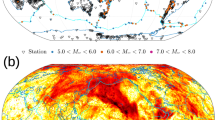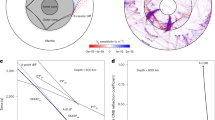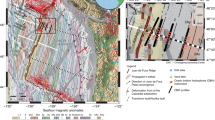Abstract
THE deep seismic zone associated with the Izu–Bonin arc dips at about 40° towards the south-west beneath the Dodaira Observatory, Japan (Fig. 1). At this observatory an unexplained phase with apparent velocity of 16.5 km s−1 was observed 10–20 s after the first arrival for earthquakes in the Ryukyu Islands. No corresponding phase has been found for earthquakes of different azimuths. This unexpected phase can be explained by post-critical reflection of P waves at the deep seismic zone after strong focusing by the 400-km transition zone: this zone of reflection is apparently sharp, of the order of 10 km in thickness. Typical ray diagrams are shown in the inset of Fig. 1. The ray path involves both the deep seismic zone and the 400 km transition zone.
This is a preview of subscription content, access via your institution
Access options
Subscribe to this journal
Receive 51 print issues and online access
$199.00 per year
only $3.90 per issue
Buy this article
- Purchase on Springer Link
- Instant access to full article PDF
Prices may be subject to local taxes which are calculated during checkout
Similar content being viewed by others
References
Kanamori, H. Bull. Earthq. Res. Inst. Tokyo Univ. 45, 657–678 (1967).
Utsu, T. Geophys. Space Phys. 9, 839–890 (1971).
Okada, H. thesis, Hokkaido Univ., Sappro (1977).
Author information
Authors and Affiliations
Rights and permissions
About this article
Cite this article
FUKAO, Y., KANJO, K. & NAKAMURA, I. Deep seismic zone as an upper mantle reflector of body waves. Nature 272, 606–608 (1978). https://doi.org/10.1038/272606a0
Received:
Accepted:
Issue Date:
DOI: https://doi.org/10.1038/272606a0
Comments
By submitting a comment you agree to abide by our Terms and Community Guidelines. If you find something abusive or that does not comply with our terms or guidelines please flag it as inappropriate.



